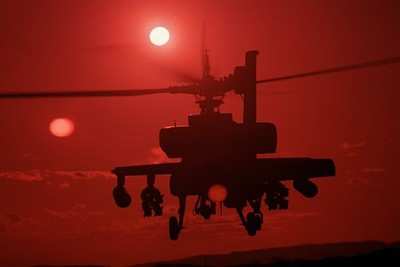Crewmembers Can Receive UAS Video In The Cockpit
Following the conclusion of a three-day journey originating from the manufacturing facilities in Mesa, Ariz. the 1-229th Attack Reconnaissance Battalion at Joint Base Lewis-McChord (JBLM), Wash., has become the first operational unit to receive the AH-64E version 6 (V6) Apache helicopter.

The V6 is equipped with an open systems design including the latest communications, navigation, sensor and weapon systems. The model has multiple upgrades with the improved Lockheed-Martin Modernized Target Acquisition Designation Sight/Pilot Night Vision System (MTADS/PNVS), which includes a new integrated infrared laser for easier target designation and enhanced infrared imagery capabilities. The GEN3 Day Sensor Assembly (GEN3 DSA) doubles the sensor’s field of view and increases resolution. The addition of color imagery improves target detection and identification.
“The GEN 3 DSA adds a lot of value to the Apache. The addition of Near-Infrared (NIR) Signature, and color vision for the Gunner makes target discriminations much easier, minimizing miscommunications within the cockpit, team, or platoon,” said Chief Warrant Officer 2 Logan Featherston, a pilot with C Company, 1-229th ARB. “It fills in critical details about the target, and area around it that we didn't previously have, minimizing the risks of an engagement.”

Another pilot agreed. “It is impressive to use the GEN3 DSA under the right conditions to clearly identify objects and personnel at over 20km. The upgrades to the [Longbow] Fire Control Radar (FCR) add a maritime capability that the AH-64 community has been talking about for a long time,” Chief Warrant Officer 4 Sven Anderson, a Battalion Standardization Instructor pilot, said. “The GEN3 DSA is a real game changer. It puts the Apache into a position where our sensors are out ranging our weapon systems. We can identify targets before we are even in range to shoot them which allows us to better leverage long range precision fires from other platforms and reduce our signature.”
The V6 also has Link 16 communications, which allows the Apache to switch network connections on the spot, and merge different networks for an operational picture. This results in the delivery of real-time situational awareness to the cockpit. The software also supports the exchange of text messages, imagery data and provides two channels of digital voice.
“The GEN3 DSA, and several of the software changes overall make the system more intuitive, saving time and effort, which allows me and my peers to spend more energy and time focused outside and on the bigger picture of where the aircraft is in time and space,” Featherstone added.
Crewmembers can receive Unmanned Aerial Systems (UAS) video in the cockpit, control UAS sensors and direct the flight path of the UAS. The crewmembers can also share real-time situational awareness of the operational environment and enemy forces to Soldiers on the ground.

The Longbow radar updates adapted the capabilities to naval activities, allowing the radar to track vessels while also doubling Longbow’s detection range. The V6 software also has the ability to track small unmanned aircraft, turning the aircraft into a lethal counter-UAS platform and has Manned-Unmanned Teaming E\eXpanded (MUMT-X) software installed which allows Apache pilots to directly control Army UAS.
The Apache will remain a vital element of the US military because of the V6. “I think that the version 6 does add a safety factor on the aircrew side,” Featherston said. “The less effort pilots have to spent focusing inside on target identification, and clicking around to get the information they need, the safer the overall aircraft will be.”
This new version of the Apache is an enhanced weapon and sensor platform and a vital link between the Army’s ground forces and manned and unmanned aircraft. The upgrades allow for improved quality of training and operation on the battlefield.
 ANN's Daily Aero-Term (04.30.24): Runway Centerline Lighting
ANN's Daily Aero-Term (04.30.24): Runway Centerline Lighting ANN's Daily Aero-Linx (04.30.24)
ANN's Daily Aero-Linx (04.30.24) Airborne 04.24.24: INTEGRAL E, Elixir USA, M700 RVSM
Airborne 04.24.24: INTEGRAL E, Elixir USA, M700 RVSM Airborne 04.29.24: EAA B-25 Rides, Textron 2024, G700 Deliveries
Airborne 04.29.24: EAA B-25 Rides, Textron 2024, G700 Deliveries Airborne-NextGen 04.23.24: UAVOS UVH 170, magni650 Engine, World eVTOL Directory
Airborne-NextGen 04.23.24: UAVOS UVH 170, magni650 Engine, World eVTOL Directory





